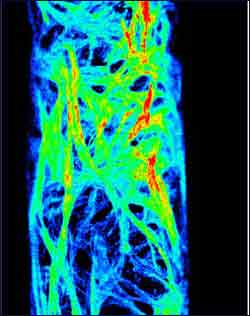Scientists Make Breakthrough In Understanding Muscle Contraction

Muscle bundles within the ureter showing different levels of calcium. The red colour shows the highest level of calcium, followed by green and blue
New research into muscle contraction will give scientists a better understanding of bladder problems and pain during childbirth.
Professor Susan Wray, who heads the UK’s top rated Department of Physiology, and Dr Ted Burdyga, are studying muscles in the wall of the ureter, which connects the kidney to the bladder, to understand how muscles respond to signals in the body telling them to contract or relax. Their research, supported by the Medical Research Council, is published in this week’s issue of Nature.
Muscles contract and relax to allow the body to perform crucial activity. Electrical signals tell the muscle when to contract, but when the muscle needs to relax, the signal is deliberately ignored. Until now scientists have been unable to understand how the body ignores this signal.
The team found that calcium, which allows muscle contraction to take place, enters the body’s cells in response to electrical signals. The calcium fills up a small structure in the cell and when this is full and starts to empty, it forces the muscle to relax by preventing any more calcium entering the cell, even when it receives contraction signals.
Professor Wray explains: “Electrical signals in nerves and muscles are important for all activity, from thinking to drinking. It is important for the body to be active, but it is also important for it to relax, so that it doesn’t over work itself. For example, in childbirth the uterus contracts and relaxes at regular intervals to allow a baby to pass through the birth canal.
“But when we get cramps for example, our muscle is contracting too hard or too often and in the case of the ureter it would cause kidney damage. It is therefore crucial that our muscles have periods of relaxation and we have now uncovered how this occurs. This understanding should allow doctors to work more accurately with the body’s natural mechanisms when treating patients.”
Media Contact
More Information:
http://www.liv.ac.ukAll latest news from the category: Health and Medicine
This subject area encompasses research and studies in the field of human medicine.
Among the wide-ranging list of topics covered here are anesthesiology, anatomy, surgery, human genetics, hygiene and environmental medicine, internal medicine, neurology, pharmacology, physiology, urology and dental medicine.
Newest articles

A universal framework for spatial biology
SpatialData is a freely accessible tool to unify and integrate data from different omics technologies accounting for spatial information, which can provide holistic insights into health and disease. Biological processes…

How complex biological processes arise
A $20 million grant from the U.S. National Science Foundation (NSF) will support the establishment and operation of the National Synthesis Center for Emergence in the Molecular and Cellular Sciences (NCEMS) at…

Airborne single-photon lidar system achieves high-resolution 3D imaging
Compact, low-power system opens doors for photon-efficient drone and satellite-based environmental monitoring and mapping. Researchers have developed a compact and lightweight single-photon airborne lidar system that can acquire high-resolution 3D…





















